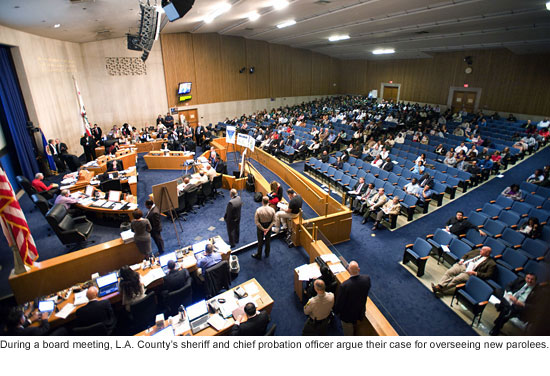Top Story: Economy
Pushing jobs, not condos, at Universal
March 1, 2012

Parts of Universal's backlot, including "Wisteria Lane," above, would be moved under home plan. Photo: AP/ABC
NBC/Universal should drop plans to build nearly 3,000 housing units on its backlot, Supervisor Zev Yaroslavsky said this week in a strongly-worded letter to studio chief Ron Meyer.
While Yaroslavsky has previously criticized the scale of the Evolution Plan, this is the first time he has pushed the studio to drop the housing component altogether. Doing so, he said, would better position Universal for a future in which it remains a strong entertainment industry contributor to the L.A. economy.
“Abandoning that portion of your plan would make long-term economic sense for this region by ensuring that Universal will remain a full-service motion picture and television production campus and a major contributor to our regional economy,” Yaroslavsky said in his letter.
Building some 2,900 condos, lofts, townhouses and apartments on 124 acres of Universal’s property would cut into the studio’s backlot and require relocation of its famed “Psycho” house. It also would mean uprooting Wisteria Lane, the setting for “Desperate Housewives,” now in its final season, and Falls Lake, where movies including “Jaws” were shot.
Even without the housing element, the 20-year Evolution Plan remains a large-scale blueprint for how the studio proposes to grow on its 391-acre Universal City site.
The Entertainment Evolution portion of the plan calls for an improved studio tour, a 500-room hotel for CityWalk, upgraded movie theaters, restaurants and stores, and new theme park attractions. (Even as the Evolution Plan has been moving through the system, at least one big new attraction, the Wizarding World of Harry Potter, has been announced, although it is not expected to open for several years.)
Meanwhile, the Studio District Evolution component of the plan includes more than 308,000 square feet of new production space, 437,000 square feet devoted to new production support facilities and nearly 500,000 square feet of new office space.
In his letter, Yaroslavsky said that those new elements, along with current operations, would create more than 34,000 permanent new jobs, whereas just building homes would yield only 2,600. And construction and construction-related jobs, he said, would still number about 15,000 without the housing component.
“In short, the expansion of the studio’s production facilities and related entertainment uses will produce far more economic benefit to our region than the apartments and condominiums that are proposed to be built under the Evolution Plan,” Yaroslavsky said.
In fact, he said, establishing a large new residential neighborhood just feet from an active entertainment studio and theme park would only worsen complaints about noise, and, in time, could force the studio to cut back on production. That, in turn, could lead to a loss of entertainment industry jobs: “None of us could possibly want such a result,” Yaroslavsky said.
The company said in a statement it would consider Yaroslavsky’s comments, along with those of community members, as part of the ongoing environmental review process. A final environmental impact report is now being prepared. That report, along with other permits, must be approved at multiple levels of city and county government before the Evolution Plan can move into action.
Richard Bogy, executive vice president of Communities United for Smart Growth, a coalition of neighborhood and business groups affected by the Universal plan, said Yaroslavsky’s letter to Meyer “really says everything that we agree with.”
Using Universal’s land to grow its entertainment businesses makes more sense than allowing it to be used for housing, Bogy said: “It’s valuable land to the entertainment industry.”
While questions remain about the overall project’s impact on infrastructure, transportation and traffic, Bogy said, dropping the home-building plan would go a long way toward assuaging his group’s concerns.
“The one really big stumbling block in the plan,” he said, “has been the housing.”
Posted 2/1/12
Resolve to check out these freebies
December 29, 2011
Whether you overspent this holiday season or just made a New Year’s resolution to be thriftier, have we got some deals for you.
Looking for a free supply of nicotine patches?
The Los Angeles County Department of Public Health has you covered, as part of its L.A. Quits program to help smokers kick the habit. (Call 1-800 NO BUTTS to get a one-month supply, gratis.)
Public Health also offers a wealth of other freebies, ranging from “Germbuster Activity Books” for kids to in-home tests for sexually transmitted diseases. HIV tests are free, too. And so is a remarkably comprehensive library of downloadable educational brochures, on topics from antibiotics and bed bugs to West Nile virus and whooping cough.
Cultural bargain-seekers are in luck as well. The Los Angeles County Museum of Art is offering free admission on Monday, January 16, in honor of Martin Luther King Jr. Day. LACMA’s “Andell Family Sundays” program resumes on January 8, with a free-with-admission art-making project called “Circle of Animals.”
More free art-making and performances are offered through “World City at the Music Center.” Next up: Khac Chi Ensemble & Korean Classical Music and Dance Company on Saturday, January 15.
Another source of potential giveaways is the Department of Public Works, which has been known to hand out free sandbags at fire stations during the rainy season as well as other freebies ranging from free oil filters to reusable shopping bags (every shopper’s must-have accessory to keep up with the county’s plastic bag ban.) Check the department’s Clean LA website to learn about upcoming events featuring giveaways in your area—as well as recycling programs for tires and motor oil and hazardous waste and electronics roundups.
But wait, there’s more! Some lucky gardeners will have a chance to win a free composting bin at one of Public Works’ upcoming Smart Gardening workshops. (Look for the green-starred events on this list.) And the county’s Waterworks Districts also give out conservation-minded freebies such as low-flow showerheads and high efficiency water nozzles; check here for more information, and download a colorful brochure on drought-tolerant plants while you’re at it.
There’s more than simple generosity behind all this county largess. The giveaways are intended to influence behavior—for the greater good.
As Public Works spokesman Michael Kaspar put it: “We’re encouraging people to integrate sustainable, environmental practices into their everyday lives.”
Posted 12/29/11
Business break for the little guys
September 14, 2011
Los Angeles County buys lots of stuff— everything from architectural services and badges to windshield wipers and welding goggles, according to this directory.
If you’re a local small business seeking a piece of the action, a new county ordinance is designed to give you a better shot at landing one of those contracts.
Los Angeles County Supervisors on Tuesday voted to increase from 5% to 8% the price preference given to small local businesses seeking county contracts. That means those businesses could come in with a price 8% higher than other bids and still seal the deal, all other variables being equal.
An analysis by the county’s Internal Services Division found that granting a price preference to small local firms has cost the county very little in the years since the initial policy was enacted in 2002. In the past three years, for example, it cost the county a total of $70,648.
“The preference is a small price to pay to help the local economy and keep jobs here,” said Internal Services director Tom Tindall. Raising it to 8% probably would cost very little more over the same period—likely $100,000 or less, he said. And it could pay rich dividends if it helped boost participation by small local firms.
“What we hope it will do is encourage more local small businesses to try” for a county contract, Tindall said.
As it stands now, local small businesses got just $184 million of the $14.9 billion in contracts and purchase orders put out by the county in the past three years. Interestingly, virtually all of them won their contracts as the low bidder, without needing any price preference at all.
Still, the hope is that sweetening the deal for the home team couldn’t hurt and might spur broader economic benefits.
“The City of Los Angeles recently implemented an 8% preference program after a USC analysis concluded that the heightened economic activity and jobs created by the program would generate new revenue that would offset any incremental costs,” Supervisors Zev Yaroslavsky and Michael D. Antonovich said in their motion pushing for the county to make the change.
Tindall said the new ordinance, set to go into effect Nov. 1, is just one of the ways in which the county is trying to become friendlier to small local firms. He said the county has a prompt payment program in which vendors are paid within 15 days of submitting an approved invoice—a boon especially for smaller business in which cash flow is a constant concern. And he noted that certified local small businesses can land sole-source contracts of up to $5,000 from some county departments.
The Los Angeles County Office of Small Business has tips for getting certified, along with other information. It also has a toll-free phone number, (855) 230-6430.
Posted 9/13/11
Finding jobs is a work in progress
September 1, 2011
 If you’re one of the hundreds of thousands of people who are out of work in L.A. County these days, this won’t come as a big surprise: It’s tough out there.
If you’re one of the hundreds of thousands of people who are out of work in L.A. County these days, this won’t come as a big surprise: It’s tough out there.
But as dispiriting as the economic news has been lately, the county has resources to help you get back to work. And, if you’re an employer, it can offer significant assistance as well—including recruiting, screening and training workers, and, in some cases, even helping to subsidize part of new hires’ salaries.
With Labor Day approaching, we took a look at some programs and initiatives aimed at making a dent in L.A. County’s high unemployment rate, currently 12.4%. Some are targeted at specific groups, such as veterans or workers 55 and older. Others focus exclusively on very low-income welfare and general relief recipients. And one upcoming program will turn its attention on those who’ve been laid off just in the past year or so.
“Everybody can use a hand. Everybody needs help,” said Richard Verches, executive director of the Los Angeles County Workforce Investment Board, one of a network of such board throughout the county. “The county has resources to help its residents.”
The Los Angeles County Workforce Investment Board recently released a report marking its 10 years of operation and spotlighting success stories over the past decade. But it was as much an occasion for “intense reflection” as for celebration, Chairman Dennis Neder said in a statement. “We are in a critical time of rebuilding our economy as L.A. County has over 600,000 unemployed, and businesses are still skeptical of hiring in this ‘wait and see’ economy.”
Some of the statistics in the report offer an unfiltered snapshot of a difficult decade, noting, for instance, that unemployment in the county more than doubled, from 5.7% in January, 2000, to 12.4% in December, 2009.
Even so, there have been some encouraging developments along the way. The county’s “Transitional Subsidized Employment Program,” geared to helping welfare-to-work clients, used federal stimulus funds to help place more than 11,000 people in subsidized jobs.
“It was the largest program in the country and probably the most successful,” said Jan Vogel, executive director of the South Bay Workforce Investment Board, which worked with the Department of Public Social Services on the initiative. “A lot of people were put to work.”
Luther Evans, DPSS division chief in charge of welfare-to-work policy, said that since the stimulus funding ran out, a new, much smaller scale initiative has been crafted in which employers soon will be offered stipends between $350 and $500 a month to offset their costs of hiring new workers from very low income families.
Another glimmer of hope is on the horizon for recently laid-off workers. Officials soon will launch a $5.7 million on-the-job training program in one or more local industries that have experienced layoffs, Verches said; a similar $2 million grant to the city of Los Angeles is expected to help laid-off teachers and other employees of the Los Angeles Unified School District.
Military veterans, meanwhile, can take advantage of a new county-funded veterans employment project, coordinated by Goodwill Industries. The program has served 380 clients since April, with 20 completing training and 17 being placed in jobs so far.
Information on all these specialized programs—and more—is available through the county’s network of “WorkSource” centers, where job-seekers of every background and experience level can get training, resume-writing help, interview coaching and other services.
“These are services that are available for job-seekers and employers,” Verches said. And, given the state of the economy, the price is right: free.
Posted 8/30/11
The sheriff vs. the probation chief
July 12, 2011
 Two of Los Angeles’ most powerful criminal justice agencies faced off Tuesday during an extraordinary meeting of the Board of Supervisors, each arguing that they’d be better equipped to handle the surge of parolees who’ll soon be flowing into the county as a result of the state’s budget crisis.
Two of Los Angeles’ most powerful criminal justice agencies faced off Tuesday during an extraordinary meeting of the Board of Supervisors, each arguing that they’d be better equipped to handle the surge of parolees who’ll soon be flowing into the county as a result of the state’s budget crisis.
Under Gov. Brown’s “realignment” spending plan, California’s counties are being given responsibility for overseeing thousands of low-level state prison inmates who will be released to ease prison overcrowding and to save money. Although the state has agreed to provide funding to the counties for the first year, there are no guarantees beyond that.
Virtually everywhere else in the state, county probation departments have been tasked with these new duties, which are similar to those they already perform. But in Los Angeles, Sheriff Lee Baca has offered a novel and controversial proposal, contending that the public safety mandate of his department should be broadened to include the rehabilitative work of parole supervision.
On Tuesday, Baca took on Los Angeles County’s Chief Probation Officer Donald Blevins, who argued that his agency is not only more qualified to oversee the new parolees but that it can do so at a better price for taxpayers. The Board of Supervisors’ hearing room was crowded largely with Probation Department supporters.
The supervisors, who had strongly opposed Brown’s realignment proposal, challenged the two agency leaders to defend the content and cost of their proposals. Some expressed concerns that neither department—both of which have come under federal scrutiny for facets of their operations—could deliver on its promises. Several supervisors suggested that a hybrid of the two agencies should be considered. In the end, the board asked the Chief Executive Office to report back with an analysis of the competing proposals.
Critics of Baca’s bid contend that the Sheriff’s Department has no institutional expertise in overseeing parolees, a job more akin to social work because of its emphasis on reintegrating ex-prisoners into society. But the sheriff pointed to his record as a leading advocate for inmate rehabilitation and his department’s success in working with community-based re-entry programs.
“My department has the largest education-based incarceration program in the nation,” he said.
At the same time, Baca argued that the reach of his department could help protect the public from problems that might arise from such a large number of former inmates suddenly returning to live in Los Angeles County.
“This is a seven-day-a-week, 24-hour-a-day problem, and therefore resources must be dedicated to ensure that felons in the system understand we have the capacity to supervise them any time, any place, any time relative to the week,” Baca said.
Chief Probation Officer Blevins, for his part, acknowledged that his department has been plagued by problems in its juvenile camps. But he emphasized that it has an excellent record in supervising adults, many of whom are ex-felons and account for more than 70% of the department’s workload.
“We have a proven track record of working with this population,” Blevins said. Moreover, he said, the Probation Department could better comply with a legal mandate encompassed in the state legislation requiring the county to use “evidence-based” practices to reduce recidivism among state parolees. One probation program for probationers aged 18-25 at a county day reporting center has cut recidivism from 39% to less than 22%, he said.
The Probation Department’s plan, he said, “does not focus on suppression and incarceration over rehabilitation…It does not complicate and confuse the clients in terms of the roles and responsibilities of officers. It does not require building, learning and training to a brand new infrastructure that potentially can take years to implement and operate efficiently.”
Although the supervisors did not vote on the matter, several seemed openly wary of Baca’s plan, especially given its higher one-year cost estimate–$37 million versus $28 million for the Probation Department.
Supervisor Zev Yaroslavsky, for one, suggested that the board might not even be considering Baca’s proposal were it not for his reputation as one of law enforcement’s most forward-thinking figures.
“You’re unique, Lee,” the supervisor said told the sheriff. “The only reason this has been given the time of day is because you’re proposing it. If this had come from just about anybody else in law enforcement, I don’t think it would have been given serious consideration.”
Posted 7/12/11
Lights, camera…fee increase
June 28, 2011
 The Dark Knight can look on the bright side.
The Dark Knight can look on the bright side.
Producers of the next “Batman” movie, now planning a 14-day film shoot in Los Angeles County flood control channels, will be paying $300 a day for the privilege—not the $798 daily rate set Tuesday as part of a new inspection fee structure approved by the Board of Supervisors.
Projects such as “Batman” got in under the wire by applying to film before the board action, and will be charged the old rate, said Maryam Adhami, a senior civil engineer who handles permits for the county Department of Public Works.
The fee hikes for filming in flood control channels and on county roads are intended to help Public Works recover its inspection costs. They come after supervisors in April approved a package of other Public Works fee increases—including for permit issuance and processing—that apply to entertainment industry production companies as well as other kinds of firms.
The Public Works department is not alone in seeking to offset its costs. New county Fire Department filming fees also have been enacted. And those are in addition to “use fees” charged for filming in locations such as county beaches and parks, and for applying for a permit from FilmL.A., the private, nonprofit agency that coordinates filming for the city and county of Los Angeles. (This March, 2011, report gives an overview of the various location fees charged by the county.)
“The biggest problem we see is that there seems to be a tremendous increase in fees at a time that we’re struggling to keep filming in Los Angeles,” said Ed Duffy, business agent for Teamsters Local 399, which represents location managers. While a $798 inspection fee for the first day of shooting in a flood control channel may indeed be justified, Duffy said, there seems to be less basis for charging the same rate for additional shooting days on the same project.
Filming permits for the county’s flood control channels—immortalized in films such as the “Terminator” series and “The Italian Job”—were issued 22 times during fiscal 2010-2011, while county road filming permits were granted 549 times, according to a Public Works review. The department collected a total of $194,931 for both kinds of shoots—but its costs were $409,225. Had the new fee structure been in place, it would have received a total $410,337.
Inspection fees for filming in county flood control channels have not increased since they first were enacted in 1982, Public Works Director Gail Farber said in a letter to the board. Inspection fees for county roads had a “moderate increase” in 1998, and have been adjusted according to the consumer price index since that, she said. The board’s action Tuesday increased both kinds of fees.
Dennis Hunter, deputy director of Public Works, told supervisors that some in the industry are concerned that the department is charging separate permit fees for filming in multiple locations. Hunter said that the newly-enacted fees will be monitored for six months to make sure that the department is just covering its costs—not turning a profit at the production companies’ expense.
Overall, filming activity is down in the county, although it is too soon to say whether that is due to recent fee increases, said Donna Washington, FilmL.A.’s vice president for operations. She said a fee hike from $300 to nearly $800 a day to shoot in a flood control channel could prompt a production company to look elsewhere.
“They’d probably try to find somewhere else to shoot,” Washington said.
Still, she said that she understands that county departments are facing financial pressures of their own.
“The perception is that the county is being anti-filming. I don’t think that’s the case. The departments have all been told to do cost recovery.”
Posted 6/28/11
Job scams work when you don’t
June 23, 2011

Navigating the job market can be frustrating in these difficult economic times. But unemployment can go from bad to worse when job hunters become the target of scammers on Craigslist and other classified advertising sites.
Con artists exploit the desperation of the jobless by tricking them into divulging personal and financial information, says LA County Department of Consumer Affairs’ Acting Director Rigo Reyes. They then use that information to defraud the victim.
“This is always a problem when the economy slows down,” Reyes says. “We have seen a significant increase over the last year or so, not just in numbers, but in the complexity of the scams that they try to get you with.”
You can identify fraudulent job offers by arming yourself with information. According to Reyes, the two most important things to watch for are guarantees of employment and companies or individuals asking for payment up front.
Reports from the Federal Trade Commission and Privacy Rights Clearinghouse list other red flags and suggest some precautions:
Red Flags
- Requests for financial information (account numbers, credit card numbers, etc.)
- Requests for a Social Security number
- Requests to scan your ID card, or for a scan of your ID card
- Absence of a company name or contact information
- A contact email address that is not a primary domain (for example, when the hiring company is “Omegacorp” @yahoo.com instead of @omegacorp.com)
- Misspellings and grammatical errors
- Promises to get you a job
- Employment services that charge an up-front fee
- Reluctance by the hiring firm to answer your questions
- Ads containing such terms as “PayPal”, “package-forwarding”, “money transfers”, “wiring funds”, “eBay” or “foreign agent agreement”
Precautions
- Make sure you understand your duties and the employer’s duties
- Take time reading contracts and avoid high-pressure sales pitches
- Follow up with the company that listed the ad
- Check with Consumer Affairs, the state Attorney General’s office, and the Better Business Bureau to see if complaints have been filed against the company
- Research the company before sending your resume or any personal information
- Target your search to the type of job you are seeking
- Do not give prospective employers your money or financial information (after all, aren’t they supposed to be paying you?)
- Be wary of companies that want you to sign up for direct deposit before you have started work
Craigslist and other classified ad sites offer their own warnings and have security measures to protect users, but scammers often find ways around them. Furthermore, the websites are not legally responsible for the listings. The people who place the ads are responsible, says Reyes, but odds are against you getting your money back. Many of the scams originate outside of the country and are difficult to track down.
While some scams are fairly blatant, others are more clever, Reyes says. Some scammers use professional looking logos and websites. And when they steal, they take small amounts that embarrassed victims usually don’t report, and that law enforcement officials are often unwilling to prosecute.
If you find yourself victimized by a scam, you can take some action. If the scammers accessed your finances, close all accounts at the bank where it took place. Register a fraud alert with all three credit bureaus—Experian, Equifax, and TransUnion—and report the fraud to Consumer Affairs. The agency investigates complaints and presents viable cases to the City Attorney and the District Attorney for prosecution. You can call Consumer Affairs officials at (800) 593-8222, e-mail them here, fill out an online complaint form, or visit their office at 500 West Temple Street, Room B-96.
Finally, Reyes warns job hunters to guard their privacy online.
“A resume is basically an outline of your life. Who knows what they are going to use that information for?” he says. “Unless you are on a very reputable site, be extremely careful with your personal info. Once it goes online it is very difficult to get it back.”
Posted 6/23/11
This budget’s a labor of love
April 22, 2011
In some parts of the nation these days, public sector unions are battling a perception that they’re the bad guys—out only for themselves as government budgets dwindle and services wither. But in L.A. County, unions have another rep—as recession-savvy partners whose sacrifices are helping to save the day.
County unions, now going into their 3rd year of working without raises, have emerged as some of the improbable heroes of a proposed $23.3 billion budget which—at least for now—includes no layoffs or furloughs. The county’s situation is particularly striking in comparison to the city of Los Angeles, where generous employee pay raises gave way to a dire economic picture including both layoffs and unpaid furlough days.
People on both sides of the bargaining table attribute the county’s situation to sound financial stewardship before the economic collapse and to long-running collaborative relationships between the unions and the county’s elected and executive leadership.
Not to mention the fact that union leaders—correctly, as it turns out—anticipated that the downturn would be long and ugly, not a short-term blip, and could jeopardize jobs.
“We saw what was coming, and it wasn’t looking good,” said Steve Remige, a director of the Association for Los Angeles Deputy Sheriffs (ALADS) who was the organization’s president during the most recent rounds of contract negotiations. Doing without raises, under the circumstances, “was an easy sell to the membership.”
It was harder over at SEIU Local 721, where some members at least initially expected a shorter-lived recession. “Some thought it would be over in a year or two,” said Bob Schoonover, president of the local, which represents some 55,000 county workers “from custodians to nurses.” By toughing it out and agreeing to no raises, however, the members not only helped avoid layoffs in their ranks but also contributed to keeping public services afloat, he said.
“We agreed to a series of no-raise contracts…in order to keep services going at the level they need to be,” Schoonover said. “The county and SEIU have had a very good working relationship for the last few years. That’s to the benefit not only of the members but to the public.”
Because of the sheer size of the county workforce—salary and benefits for nearly 100,000 employees, most of them unionized, account for 40% of the budget—even a tiny cost-of-living adjustment carries a huge price-tag.
As it is, the proposed budget unveiled this week reveals a $220.9 million shortfall that the chief executive office says can be eliminated through, among other things, one-time funding, the elimination of vacant positions and department cutbacks—but without forcing anyone into unemployment.
And for that, Supervisor Zev Yaroslavsky and others give substantial credit to the unions and their leadership. “They made a tough decision for themselves and for their members,” he said.
Labor and management both credit the long tenure of the board majority—and the trust that has flowed from it—with creating the climate for union concessions.
“Good labor relations demand a certain longevity,” said Blaine Meek, counsel for the California Association of Professional Employees, which represents some 2,700 county employees in departments such as Public Works, Treasurer-Tax Collector and Assessor.
So when the Board of Supervisors made it clear that without union cooperation, the county’s fiscal health would suffer and workers would lose their jobs, the unions decided to play ball.
“At the end of the day, they went along with us,” Yaroslavsky said. “I think they wanted to do something statesmanlike. And the proof of the pudding is three years later, we haven’t laid off anybody and we haven’t furloughed anybody.”
Jim Adams, chief of employee relations for the county, said the current season of labor-management harmony is no mere “kumbaya thing.” He acknowledged that labor agreements in recent years have asked county employees to do without raises at a time when workloads are increasing and vacancy and promotional freezes are in place.
“These sacrifices have strained our employees at times,” Adams said.
But those sacrifices looked more palatable when compared to what was happening in other places.
“People were seeing layoffs and furloughs all around us,” Adams said. “They were seeing worse things going on elsewhere than a salary freeze.”
The austerity contracts started in early 2009 with ALADS and the county’s other public safety unions. Setting the stage for the negotiations with other county unions that would follow, they accepted no raises and a 50% reduction in the amount the county pays in deferred compensation. But they won a larger county contribution to their rising health insurance premiums.
Now, with small signs of a recovery on the way, county union members are keeping one eye on the local economy and the other on their union brethren around the nation.
“They see that public employees have been made a target in a bad economy, even as the demand for government services is rising,” said Meek, of the California Association of Professional Employees. “Yes, our members are anxious. Even their voice in collective bargaining is under attack.”
But in their dealings with L.A. County, there is a sense that sacrifices in bad times will be rewarded when things get better.
“There is an expectation,” Meek said, “that when conditions improve that we will go forward and get back to pay raises and addressing other issues.”
Or, as the SEIU’s Schoonover puts it: “We’re all hoping we return to whatever normal is.”
Posted 4/21/11
An L.A. state of mind for Oscar?
February 24, 2011
 Here in L.A., we feel a special bond with the Oscars. And who can blame us for imagining ourselves gliding down the red carpet when this season rolls around?
Here in L.A., we feel a special bond with the Oscars. And who can blame us for imagining ourselves gliding down the red carpet when this season rolls around?
With the Academy Awards due on Sunday, we thought we’d take a look back at how Los Angeles County fared, show-biz wise, this season – and, just for fun, at how much of the spotlight we got.
So ten films have been nominated for Best Picture. Of those, can you guess how many were shot on location in L.A.?
Well, not counting scenes that were shot at studios here, there were four, says Philip Sokoloski, communications director of FilmL.A., the nonprofit that coordinates film permits throughout the city and county.
Best Los Angeles County Location in a Best Picture
“The Kids Are All Right,” the romantic comedy about a lesbian couple, their children, and the children’s biological father, had a lot of scenes shot in and around L.A. The father’s house is a real house in Echo Park. Scenes in which the daughter goes to college are shot in Eagle Rock on the Occidental College campus. Permits for other location shoots include the Huron Substation in Cypress Park and the Penmar Recreation Center in Venice.
“The Fighter,” David O. Russell’s New England boxing movie, is set in Massachusetts and was largely shot there. But the permits indicate that several scenes were shot locally. One cites the Pan Pacific Warehouse in L.A.’s Downtown loft district; another gives the address of BASF Corp., an industrial building downtown that’s often used as a stand-in for boxing gyms.
“The Social Network”—which shot at such L.A. landmarks as the Hancock Memorial Museum on the USC campus, the Wilshire Ebell Theatre and the old Los Angeles Stock Exchange building for its story of the founding of Facebook—also filmed some of its Silicon Valley scenes at a private home in Altadena on Mendocino Street, records show.
And then there’s “Inception,” which was all over L.A., from Berth 200H of the Port of Los Angeles to a beach in Palos Verdes. But we like to think the star was the county’s own Music Center, where, on a day in mid-October, the backdrop for the futuristic dream movie was the Ahmanson Theatre.
Best Performance in an Economic Indicator
Meanwhile, the good news, according to the Los Angeles County Economic Development Corporation, is that the entertainment industry rebounded last year from a wrenching 2009 throughout Los Angeles County, with about 16,500 more Hollywood jobs and “more motion pictures, television pilots and shows and commercials being filmed.”
More on-location filming, too. FilmL.A. recorded a 15% increase in film permits last year. The bad news, as Southern California grapples with a struggling economy and runaway production, is that feature production was less than half of what it was in the mid-1990s. But new state tax credits made a big difference – in fact, FilmL.A. found, they were responsible in 2010 for more than a quarter of L.A.’s local feature film production. And the fourth quarter was especially good.















 405 bridge work causes a stink
405 bridge work causes a stink
